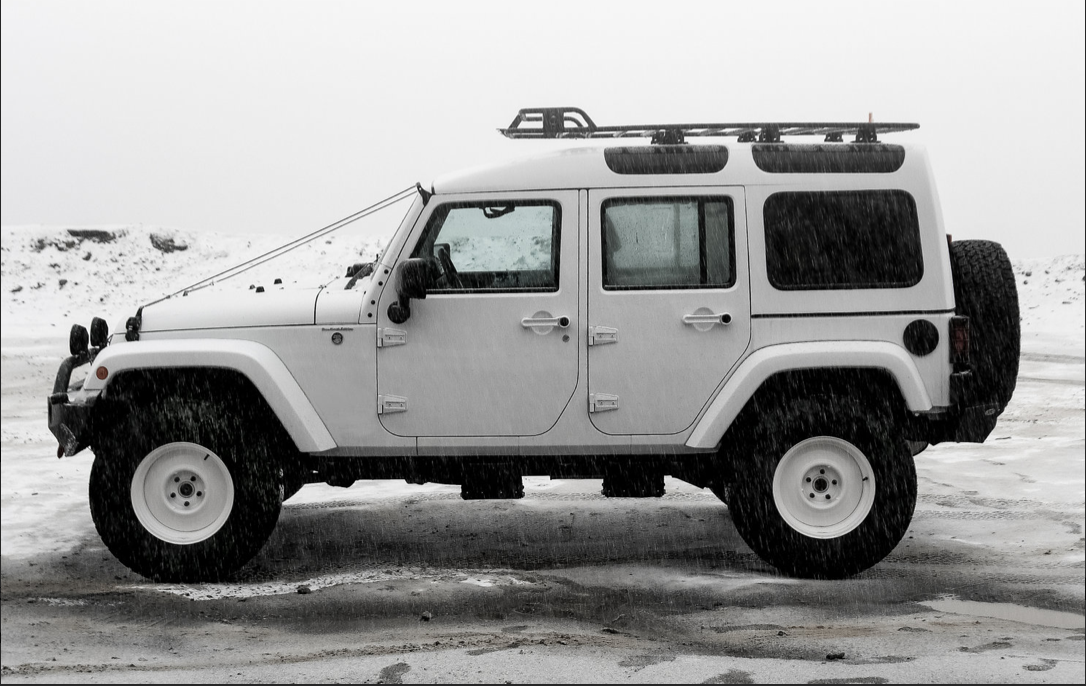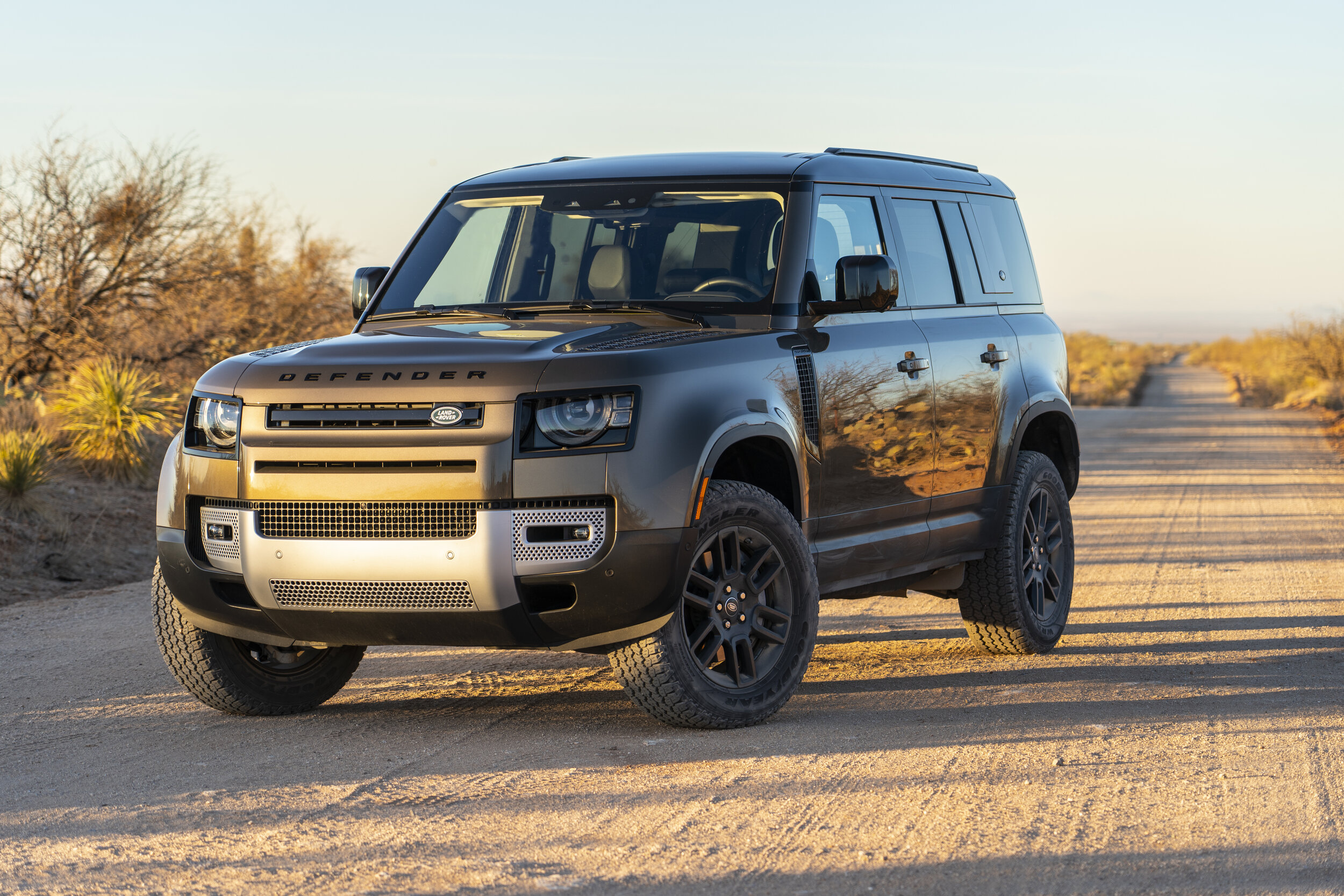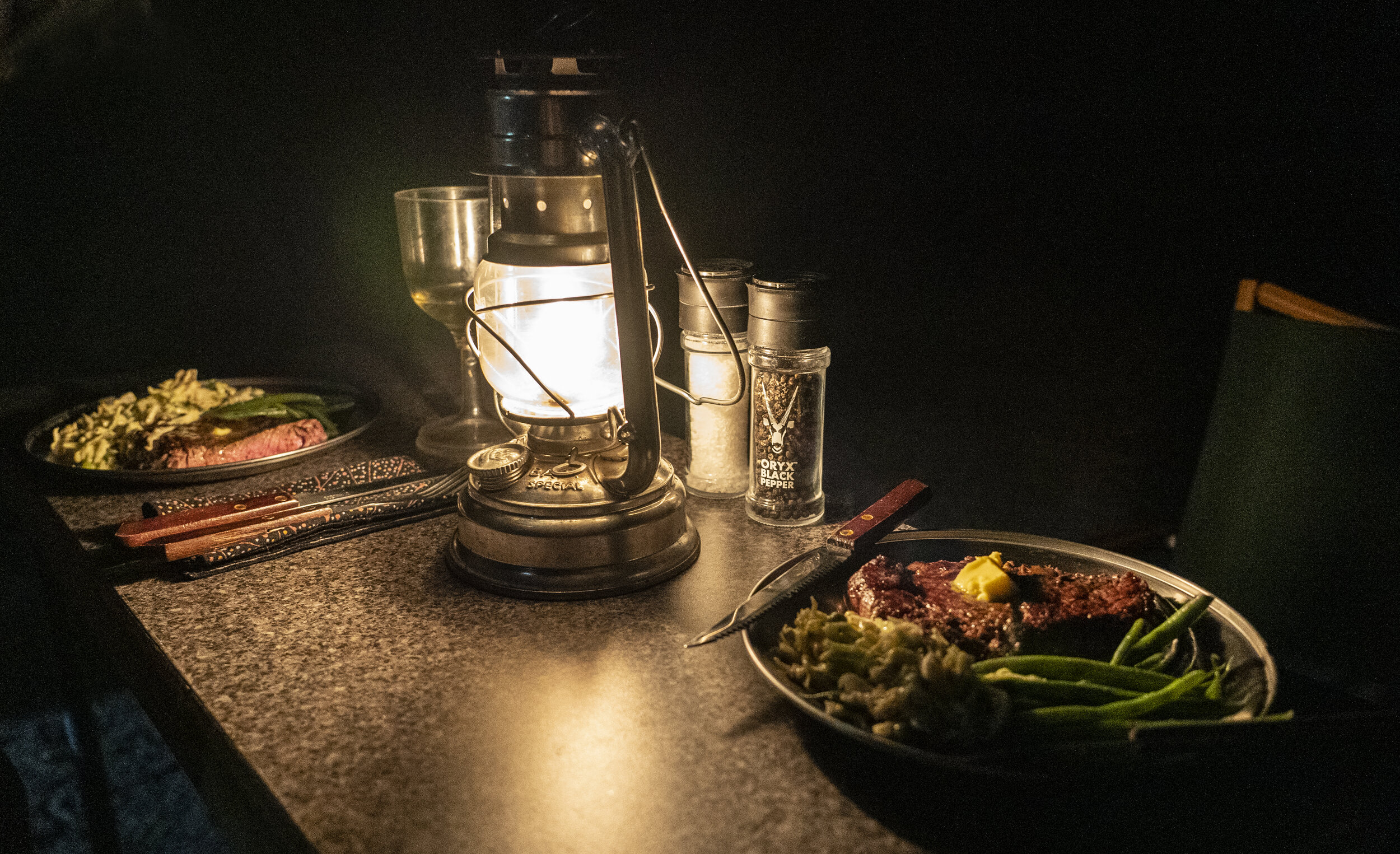
Overland Tech and Travel
Advice from the world's
most experienced overlanders
tests, reviews, opinion, and more
The True North Collections Jeep Wrangler
A post in a Land Rover group on Facebook alerted me to this: the True North Collections Jeep Wrangler—described in TNC’s words as, “AN AMERICAN LEGEND REIMAGINED.”
Uh oh. Any time I see the word “re-imagined” these days, the first thing I think of is a ghastly tart job on some unfortunate, formerly workmanlike and practical classic vehicle: diamond-pleated, contrasting-stitched, distressed-leather upholstery, digitized (and leatherized) dashboard, video monitors in the headrests of the Recaro seats, extraneous exterior styling bits. Usually you’ll find special badging embossed in the leather and/or displayed in bronze escutcheons on the fenders.
(There are exceptions. Singer’s glorious “re-imagined” Porsches reach a sublime plateau of craftsmanship and performance we might have expected had God spent the eighth day working on his personal 911. Another story entirely. But in general such projects have all the taste of a Middle Eastern potentate’s bathroom.)
My initial reaction to the TNC Wrangler—advertised as a 2017 model with only 400 miles on the odometer— was that for some inexplicable reason they tried to turn a Jeep Wrangler Unlimited into an original-version Land Rover Defender 110. Second reaction—same thing. The all-white U.N. paint job recalls the 500 limited-edition NAS 110s of 1993-1995. There’s the raised, Defenderesque roof with not one, but two Alpine windows, just so we get the point. folding, Defenderesque steps. The weird white solid-disk wheels, however, don’t very well replicate Land Rover Wolf wheels. De rigueur tail lamp brush guards are there. But, no checker plate on the bonnet?
Then there are the limb risers.
On all but a very few vehicles, limb risers (also called brush wires) are more or less the ultimate poseur accessory. They were originally designed for vehicles that had to push through extremely thick brush—think overgrown Central America rain forest. A few regions in the U.S. grow vegetation quickly enough that vehicles on a legitimate route might employ them effectively—narrow forest trails back east, for example. Otherwise, unless you’re driving somewhere you probably shouldn’t be, they’re strictly a fashion statement.
Look at these closely. Assuming an owner of a TNC Wrangler might actually take his vehicle somewhere limb risers might be necessary, I’m dubious that the flimsy looking mounting hardware would hold up to the stress of shoving chest-high branches and limbs up to roof height. And if it did? Take a look at the roof rack, which will function as a beautiful limb-catchment device, with a front mounting bracket a good three feet behind the front edge. Any limbs raised there would be stuffed into the gap between roof and rack, and either rip the rack off its mounts or rip bushels of branches off passing trees and leave them wedged in place. An automatic firewood-gathering device, perhaps? Let’s hope you didn’t pick up a fer-de-lance with the kindling. Additionally, the dinky Hella driving lamps perched atop the front bumper’s bull bar would either be ripped off as well or at the very least wind up aimed skyward.
There’s a winch in the bumper as well, but I can’t tell anything about it from the photos, and the TNC site is silent on its specs.
On to the interior, about which, sure enough, TNC says, “We took the stock interior and elevated it with bespoke vintage inspired brown leather.” The photos only show snippets, but I have to say this facet of the vehicle at least appears restrained and handsome—if you’re into leather upholstery in an overlanding vehicle. They also note “billet aluminum shifter, AC vents, and knobs to replace the original plastic.” (Have you ever thoughtlessly grabbed a billet aluminum shifter that’s been basking in the summer Arizona sun for an hour or two? I have.)
Obviously I’ve not seen this vehicle in person, much less driven it. But it’s fair to wonder about their target customer. A serious explorer, or just someone who wants the look and attention? Perhaps the final paragraph in the pitch is a clue:
“Included with the sale of this Wrangler is our bespoke leather luggage option, and handmade bespoke key tag with the Edition # of the vehicle as well as a coffee table book with breathtaking imagery of this Jeep in city and mountain settings. There is no truck/suv on the market today, this unique and with this much press anywhere in this price range.”
If you’re interested, the True North Collections site is here.
The new Land Rover Defender . . . in brief
My full review of the new Defender is scheduled for the spring issue of Wheels Afield, and as that was contracted I can’t offer all my thoughts here. However, I can offer a few, and a general conclusion.
My basic conclusion (Roseann’s as well) is that if Land Rover had named this vehicle anything but “Defender,” Land Rover fanatics would have greeted it rapturously. It’s really only the heady baggage of that name that created the uproar.
Over the course of five days we employed it for everything from serious rock crawling to freeway driving, and everything in between. And it handled them all with more aplomb and balance than any vehicle either of us has experienced, including JLR’s own premium models.
How so? Because the Defender’s all-independent air suspension offers 90 percent of the highway comfort of the Discovery and Range Rover—in other words, lots—while clearly being more biased toward backcountry capability than either. Exactly what most overland travelers I know want. The superior ground clearance and approach/departure angles were apparent while maneuvering around and over boulders, while Rock Crawl mode on the Terrain Response menu provided plenty of traction. Yes, I would prefer a full manual front locker instead of the traction-control version supplied, but with the center and rear diffs locked there was never anything we couldn’t climb.
Styling? It will certainly never be mistaken for a Series II, but some of that was inevitable in this day of aerodynamics and safety systems. I still give a thumbs down to the Angry Birds headlamp look and the Martha Stewart sample swatch of body color stuck in the middle of the greenhouse.
All is forgiven once you step inside. A dashboard I never dreamed would make it beyond the prototype stage in fact went straight to production, and it is simply stunning. Bentley should accomplish such elegance in a dash.
More important, the cargo area with rear seats down is eminently practical—rubber matted and perfectly rectangular. There is just enough room for my 5’9” to lie down inside; if, for couple-only travel, you removed the rear seat squabs (the back edges of which protrude above the flat floor) you could easily arrange a platform six inches longer.
On the road any resemblance to the old defender vanishes. My test vehicle had the Ingenium 3.0-liter straight six (hurrah for straight sixes!), electric supercharged and turbocharged, with 395 hp and 407 lb.ft. The owner’s manual recommends “not driving for long periods above 100 miles per hour.” I’ll bet no warning like that has ever appeared in a Defender manual before.
Of course . . . sigh . . . the big question, as always with Land Rover, will be reliability. There have already been a couple of alarming experiences documented on YouTube and elsewhere. I’m praying to the overlanding Gods that the Slovakia production plant can exceed its predecessor in Solihull in this department. Yes, that’s right: The British icon is no longer built in Britain. Some will gasp in horror; some will think smart move.
I will say this: Roseann and I both agreed we’d be happy to own one.
As long as we got to keep our original one too . . .
One-Case Toolkit – Episode 3 – Tool Rolls and Cases (Online Workshop)
This is part three of the One-Case Toolkit series online. Please note we had some bandwidth and camera-quality technical issues on this recording, so parts of the over-head camera show-and-tell stutter a bit, but the information is solid!
Assembling a quality set of tools for a field repair kit is only half the job. For tools to function efficiently and make repair jobs easier, they need to be stored properly, in a way that protects them, reduces noise, and above all keeps them organized and logically accessible. In this segment Jonathan will discuss ways to do that, from Pelican cases to Wolf Packs to Zarges boxes, and a variety of tool rools.
An interactive Q & A session is included.
Length: 1 hour, including Q&A
Resources from the Episode:
Company websites:
http://www.adventuretoolcompany.com
http://www.blueridgeoverlandgear.com
Tool Storage Products:
Step22 Pangolin $145
Step22 Stingray box $85
ATC Wrench Roll $60
ATC Shop Roll $100
Blue Ridge Tool Bag $136
Blue Ridge Recovery Bag $70
7POverland sells their recovery kit in this bag https://7p.io
Socket rails: Amazon—Casoman 6-piece ABS socket organizer ($19.97)
Tools mentioned:
Hammer – https://www.parktool.com/category/tools
Ground cloth – Rescue Essentials QuikLitter https://bit.ly/2N56HmM
and https://www.blueridgeoverlandgear.com/collections/tools/products/trail-creeper-multi-mat
Nissan electric van camper concept
Nissan has introduced an interesting all-electric van in Europe, called the e-NV200 Evalia (why not just Evalia I have no idea). In its standard form (below) it looks good, and promises a range of “up to” a middling 187 miles.
Now the company has released images of a pop-top camper concept, shown adventuring in snowy conditions somewhere. Consider that for a moment. An all-electric vehicle obviously uses a lot of energy to heat the interior in frigid weather, which means that “up to” maximum range is going to be butchered. In fact one of the publicity shots shows a couple who look for all the world as though they’ve just awakened from an frigid night to find their vehicle stone-cold dead and immobile, and are dully trying to heat some water for coffee to stave off hypothermia while waiting for the concept vehicle’s roof-mounted solar panel to recharge the battery bank enough to drive home on—a process that shouldn’t take more than a week if they don’t turn on a single LED accent lamp in the interim.
However, in the next photo they look much, much happier—I suspect because in the meantime they’ve pulled out the front seats and burned them to warm up and/or signal for help.
Ah, well, I guess that didn’t work. Here they are preparing to attempt to ski back to civilization.
No word on when or if the Evalia will be released in the U.S.—or whether the couple survived.
The kerosene lantern . . . still perfect.
After a (very) leisurely holiday break, I thought I would bring in the new year with an eye-rollingly obvious metaphorical piece on camp lighting, symbolizing 2021’s new beginning in either calendar or political terms, or both if you prefer. (Edit: I started this piece before January 7. Perhaps I need to wait a bit before actually turning on any metaphorical lights in the darkness.)
This is a specific bit of camp lighting, however, and one we keep coming back to no matter how much we experiment with alternatives. I’m referring to the classic kerosene lantern (aka hurricane lantern or storm lantern).
The hurricane lantern—that is, the universal style you’ll recognize that incorporates a hollow tube on each side of the glass globe, and a perforated cap above—is not the simple device most people believe. It came about as a product of evolution and ingenuity.
The first moderately efficient oil lamp was invented by Francois-Pierre Aime Argand, the son of a Swiss watchmaker, in the late 1700s. His lamp employed a fuel tank at the bottom, of metal or pottery, with a wick controlled by a knob, and a glass globe to provide some protection for the flame. It was a huge improvement on earlier, open-flame oil lamps with no control, which flickered with the slightest air movement, but not very bright due to poor oxygen supply, and still susceptible to gusts of wind. Also, if tipped over or broken it could easily start a fire.
Later oil lamps incorporated perforated rings at the base of the globe, which allowed fresh air to enter at the base of the flame, creating a hotter and thus brighter light. These were still susceptible to gusts, however. These lamps are referred to as “dead flame” lamps, since they rely on a simple, unchanneled supply of air.
In 1869 a young man named John Irwin, whose father had complained about oil lamps that blew out, received a patent for the “hot blast” lantern, which employed hollow tubes arcing from the base of the burner assembly to the vented top. These tubes returned some of the heated air from the burning wick to the base, and by providing this draft-free supply almost completely shielded the flame from gusts or movement. Robert Dietz, a manufacturer of oil lamps in New York, quickly bought the rights to produce the hot blast lantern.
Four years later Irwin introduced the even more revolutionary cold blast lantern, which has survived nearly unaltered to this day. In a cold blast lantern, the hot air rising from the flame, which is depleted in oxygen, is vented away from the tubes, which draw in only fresh air to feed the flame, significantly enhancing efficiency. Another happy characteristic of the cold blast style is that if the lantern is tipped over, the flame extinguishes itself, an enormous benefit in safety. While Dietz makes a retro hot blast model, virtually all hurricane lanterns you find today are of the cold blast type.
The Dietz company went on to produce millions of cold blast kerosene lanterns, eventually starting production in China in 1957—at the time more in an effort to capture developing-world sales than to save production costs. As things turned out, of course, the China factory was the only one to survive.
Meanwhile, in 1877, a German silverware maker named Karl Hermann Nier started producing miner’s lamps and household lanterns. In 1902 he established the Nier-Feuerhand (literally, fire-hand) company and began manufacturing high-quality cold blast lanterns, incorporating many patented improvements along the way. By the 1930s the Feuerhand company was the largest maker of storm lanterns in the world.
The end of WWII changed that, as the family’s manufacturing facility was in Beierfeld, which became part of East Germany. The company’s machinery was confiscated and shipped to the Soviet Union, and the family fled to West Germany, where they eventually managed to resume production. Eventually rights to the name were bought by Petromax—a legendary maker of gas pressure lanterns. Todays’ Feuerhand company produces exactly one model, the #276 Baby Special, still made in Germany.
So . . . to our camp lighting—and, specifically, to our dining lighting.
Dining lighting is different than general camp lighting. We have an extensive collection of devices for the latter, ranging from plug-in 12V LED strips to rechargeable LED lanterns to propane lanterns to a pressurized white-gas Coleman lantern. The LED lamps are cold and harsh for atmospheric dining, and the pressure lanterns are too noisy at a small table. But candle lanterns, which we tried, are really not bright enough.
We were reminded about the correct way to do things by Graham Jackson and Connie Rodman, on a trip across Australia. We’d been experimenting with a (very nice) rechargeable LED lantern, but Graham and Connie had brought their customary kerosene lantern, and when both were put on a table the LED’s glow looked gruesomely sepulchral next to the golden yellow of the kerosene flame. We fixed things next trip by purloining one of the half-dozen Feuerhand lanterns we use for casual lighting at our off-the-grid desert place outside Tucson.
The Feuerhand #276 is Goldilocks perfect. It’s silent, casts a warm light exactly bright enough for comfortable dining and conversation without being glaring (look up and you can still see the stars), and simply adds a lovely comforting air to a camp meal. It’s not so big that it steals table space, yet runs for hours on a single fill.
Admittedly, a kerosene lantern is a bit more bother than a 12V appliance. It needs to be stored upright, and unless you’re also into charmingly obsolete brass camp stoves (more on that later), it takes fuel you can use in nothing else. But trust me, it’s worth it.
A wonderful source for kerosene lanterns and the history thereof is W.T. Kirkman, here.
Hint: When using “Search,” if nothing comes up, reload the page, this usually works. Also, our “Comment” button is on strike thanks to Squarespace, which is proving to be difficult to use! Please email me with comments!
Overland Tech & Travel brings you in-depth overland equipment tests, reviews, news, travel tips, & stories from the best overlanding experts on the planet. Follow or subscribe (below) to keep up to date.
Have a question for Jonathan? Send him an email [click here].
SUBSCRIBE
CLICK HERE to subscribe to Jonathan’s email list; we send once or twice a month, usually Sunday morning for your weekend reading pleasure.
Overland Tech and Travel is curated by Jonathan Hanson, co-founder and former co-owner of the Overland Expo. Jonathan segued from a misspent youth almost directly into a misspent adulthood, cleverly sidestepping any chance of a normal career track or a secure retirement by becoming a freelance writer, working for Outside, National Geographic Adventure, and nearly two dozen other publications. He co-founded Overland Journal in 2007 and was its executive editor until 2011, when he left and sold his shares in the company. His travels encompass explorations on land and sea on six continents, by foot, bicycle, sea kayak, motorcycle, and four-wheel-drive vehicle. He has published a dozen books, several with his wife, Roseann Hanson, gaining several obscure non-cash awards along the way, and is the co-author of the fourth edition of Tom Sheppard's overlanding bible, the Vehicle-dependent Expedition Guide.




















